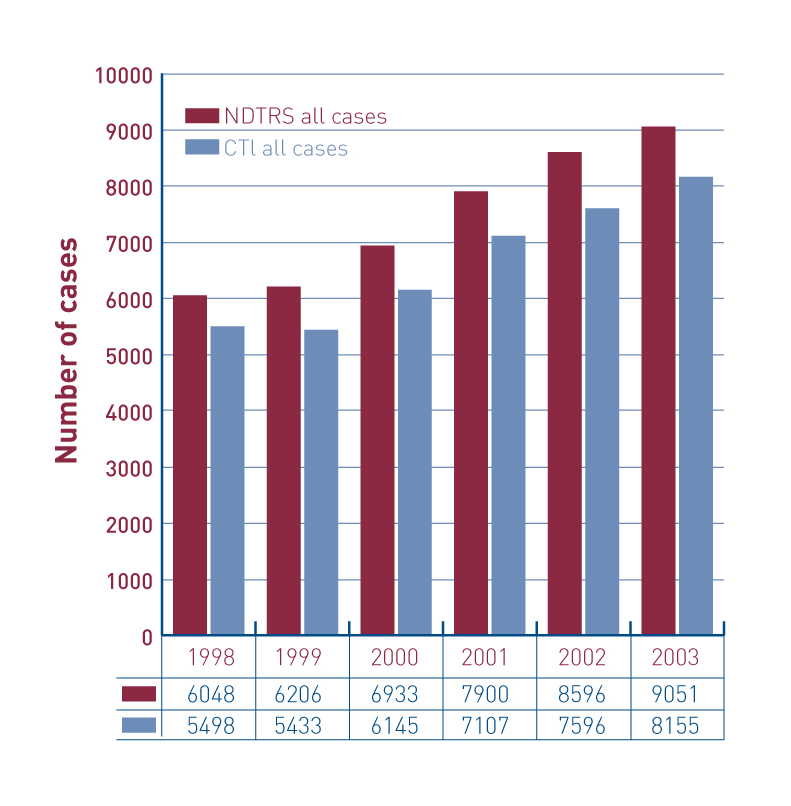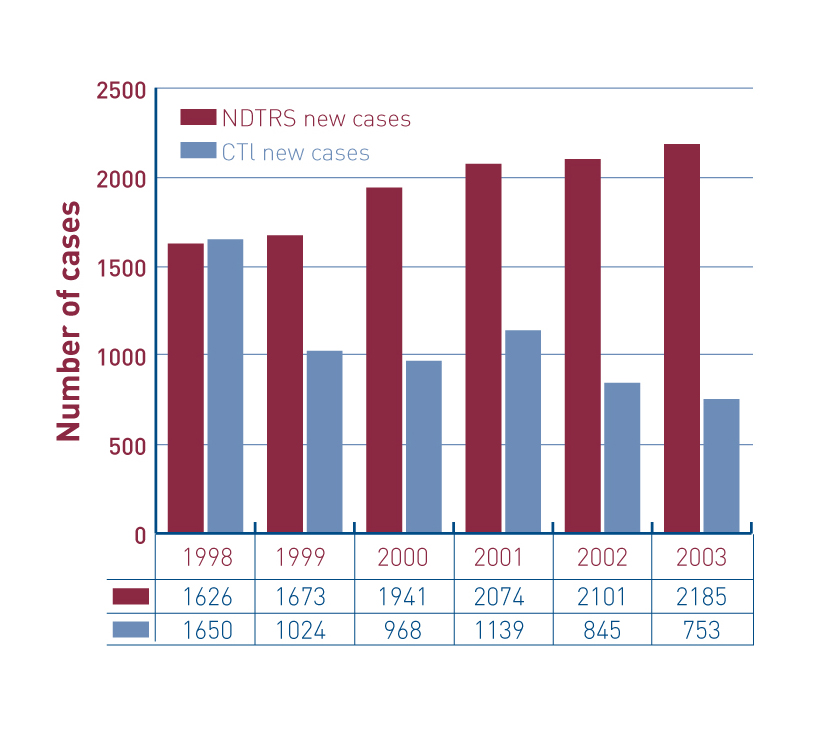Long, Jean (2005) Recording drug treatment in Ireland. Drugnet Ireland, Issue 15, Autumn 2005, pp. 11-12.
| Preview | Title | Contact |
|---|---|---|
|
PDF (Drugnet Ireland, issue 15)
- Published Version
402kB |
Two national registers record drug treatment in Ireland: the first system is an epidemiological database that records demand for treatment for problem alcohol and drug use (known as the National Drug Treatment Reporting System) and the second is an administrative database to regulate the dispensing of methadone treatment (known as the Central Treatment List).
National Drug Treatment Reporting System
The National Drug Treatment Reporting System (NDTRS) is an epidemiological database on treated problem drug use in Ireland. It was established in 1990 in the Greater Dublin Area and was extended in 1995 to cover other areas of the country. The reporting system was originally developed in line with the Pompidou Group’s Definitive Protocol and subsequently refined in accordance with the Treatment Demand Indicator Protocol. The NDTRS is co-ordinated by staff at the Drug Misuse Research Division (DMRD) of the Health Research Board (HRB) on behalf of the Department of Health and Children. Between 1991 and 2003 compliance with the NDTRS required that one form be completed for each person who received treatment for problem drug use at each treatment centre in a calendar year. Since 2004, compliance with the NDTRS requires that the total number of cases in treatment with each treatment provider on 1 January each year is returned to the DMRD and that one form is completed for every case who commences or returns to treatment for problem alcohol or drug use at each treatment centre. Data forms are submitted quarterly. Service providers at drug treatment centres throughout Ireland collect and submit this data. They collect administrative details, demographic characteristics, parameters to measure access to treatment, treatment status (new versus previously treated cases), problem substance use in the month preceding this treatment contact, risk behaviours (associated with injecting drug use) and initial treatment type.
At national level, staff at the DMRD of the HRB compile anonymous, aggregated data. For the purpose of the NDTRS, treatment is broadly defined as ‘any activity which aims to ameliorate the psychological, medical or social state of individuals who seek help for their drug problems’. Treatment options include one or more of the following: brief interventions, addiction counselling, medication-free therapy, alternative therapy, psychiatric treatment, medication (detoxification for problem alcohol, opiate or benzodiazepine use, methadone substitution), and social and occupational reintegration. Clients who attend needle-exchange services are not included in this reporting system. Treatment is provided through residential and non-residential services. Drug treatment data are viewed as an indirect indicator of drug misuse as well as a direct indicator of demand for treatment services. These data are used at national and European levels to provide information on the characteristics of clients entering treatment, and on patterns of drug misuse, such as types of drugs used and consumption behaviours. In addition, the data are used to calculate the performance indicators for the addiction services.
Central Treatment List
The Central Treatment List (CTL) was established under Statutory Instrument No. 225 (Minister for Health and Children 1998) following the Report of the Methadone Treatment Services Review Group 1998. This list is administered by the Drug Treatment Centre Board on behalf of the Health Service Executive and is a complete register of all patients receiving methadone (as treatment for problem opiate use) in Ireland. When a person is considered suitable for methadone detoxification or maintenance, the prescribing doctor applies to the CTL for a place on the list and a unique number is allocated to the client. Therefore, each client can receive their methadone from one source only. Each client’s’ name, address, date of birth, gender, date commenced on methadone, type of methadone treatment, prescribing doctor and dispensing pharmacist are recorded on the List. The CTL is considered complete with respect to the number of clients who start or recommence methadone treatment because practitioners have a statutory obligation to report the initiation of treatment and, also, they are paid per client in treatment. Once on the List, the current treatment status of the majority of clients can be tracked by means of transfer and exit records.
Figure 1 presents a comparison of the numbers of cases reported to the NDTRS and to the CTL. As expected, the numbers of cases reported to the NDTRS are higher than those reported to the CTL. Between 1991 and 2003 compliance with the NDTRS required that one form be completed for each person who received treatment for problem drug use at each treatment centre in a calendar year, whereas compliance with the CTL requires forms only for those receiving methadone. The difference is not as high as expected because the data in Figure 1 presents all cases reported to each system and it is acknowledged that between 1998 and 2003 there was a large increase in the number of general practitioners providing methadone treatment services in Ireland. The number of general practitioners participating in the CTL is high because it is a statutory requirement and payments are calculated per client treated, but the number of general practitioners participating in the NDTRS is still very low. This deficiency in the NDTRS will be rectified at the end of 2005 when all outstanding data for general practitioners’ clients for the period 2001 to 2005 will be returned and included in future publications. It is important to note that the number of cases reported to the CTL presented in Figure 1 represents the total number of individuals treated with methadone in the calendar year, rather than the number in treatment at a single point in time.

Figure 1 Total number of cases reported to the National Drug Treatment Reporting System and to the Central Treatment List (unpublished data), 1998 to 2003
Figure 2 presents a comparison of the number of new cases reported to the NDTRS and to the CTL. It is clear that more new (incidence) cases are reported to the NDTRS than to the CTL. The trend in new cases reported to the CTL is falling, while the trend in new cases reported to the NDTRS is rising. The fall in the number of new cases reported to the CTL is influenced by the decrease in opiate use in both the HSE Northern and the HSE South Western Areas (of Dublin), while the increase in new cases reported to the NDTRS is accounted for by an increase in problem cannabis use and, to a much lesser extent, problem cocaine use in Ireland.
Figure 2 Number of new cases reported to the National Drug Treatment Reporting System and to the Central Treatment List (unpublished data), 1998 to 2003
HJ Treatment or recovery method > Substance disorder treatment method
J Health care, prevention, harm reduction and treatment > Treatment and maintenance > Treatment factors
J Health care, prevention, harm reduction and treatment > Health services, substance use research
Repository Staff Only: item control page